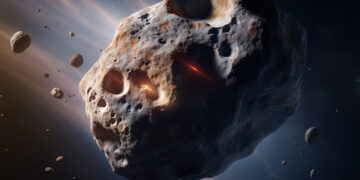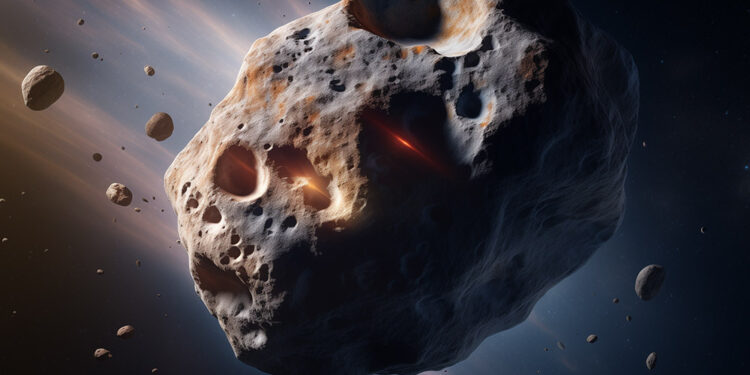In recent years, the Japanese Space Agency’s Hayabusa 2 mission to asteroid 162173 Ryugu has captivated the scientific community and stargazers alike. Ryugu, an ancient, carbon-rich space rock, has revealed some of the solar system’s most primitive and untouched materials. By collecting and analyzing samples from this asteroid, scientists hope to unlock secrets from the early days of our solar system, potentially shedding light on the origins of Earth’s water and the ingredients for life itself.
The Hayabusa 2 Journey and Its Significance
The Hayabusa 2 mission began with a monumental journey to the asteroid Ryugu, located around 300 million kilometers from Earth. Launched in December 2014, Hayabusa 2 reached its target in June 2018, studied it for over a year, and then made history by collecting surface samples. The spacecraft’s return in December 2020 marked the arrival of a rare and invaluable cosmic relic — a sample of a 4.6-billion-year-old asteroid. This matters because asteroids like Ryugu are considered “time capsules,” preserving materials that existed at the birth of the solar system.
Using advanced instruments like Japan’s synchrotron radiation facility, scientists have already begun decoding Ryugu’s structure and contents. The sample, though tiny at 5.4 grams, holds precious data that could rewrite chapters of planetary science.
Ryugu’s Rare Composition and What It Reveals
Asteroid Ryugu belongs to a rare class known as Cb-type asteroids, exhibiting characteristics of both C-type carbonaceous asteroids, which are dark and rich in organic compounds, and B-type asteroids. This hybrid nature is one reason JAXA (Japan Aerospace Exploration Agency) selected Ryugu. They suspected that Ryugu’s material could contain the building blocks of life. Observations have confirmed their predictions, revealing that Ryugu’s composition includes both organic compounds and water-bearing minerals — a groundbreaking discovery suggesting the potential for organic material delivery to Earth via space rocks like Ryugu.
The sample revealed a concentration of pyrrhotite, an iron sulfide mineral, which scientists hadn’t seen in similar meteorite samples. Further analysis using techniques like Mössbauer spectroscopy showed water inclusions within the sample’s minerals, hinting at the presence of water in Ryugu’s past. The presence of such materials implies Ryugu’s parent body formed in the cold, outer regions of the solar system, where temperatures allowed water ice to form.
Uncovering the Origins: Clues from the Outer Solar System
Why is the outer solar system significant in Ryugu’s story? Scientists hypothesize that Ryugu’s parent body originated beyond Jupiter, where cold temperatures allowed water ice to form and merge with rocky particles. The Ryugu sample’s mineral makeup and oxidation rates indicate it was exposed to icy environments, meaning its formation likely occurred where water and other volatile compounds could exist in frozen states. This contrasts with the inner solar system, where heat from the young Sun would have vaporized such elements.
The discovery of carbon dioxide-bearing water in specific crystals provides the strongest indication that Ryugu’s parent body formed beyond the H₂O and CO₂ snow lines. These findings give us insight into the dynamic processes of the early solar system and how different elements came together to form diverse celestial bodies. Understanding Ryugu’s icy, carbon-rich origins helps scientists piece together the roles asteroids played in forming planets and delivering water to the inner solar system.
The Story of Ryugu’s Parent Body: Formation, Heating, and a Catastrophic Collision
Ryugu wasn’t always a lone asteroid. In fact, it’s believed to be a fragment of a larger “parent body” that formed around 1.8 million to 2.9 million years after the solar system began. Over time, radioactive elements within this parent body generated heat, causing ice to melt and minerals to undergo chemical reactions. Scientists speculate that these internal reactions transformed Ryugu’s mineral structure from anhydrous to hydrous, meaning water interacted with the rocky materials.
Scientists found that the asteroid’s grains bear signs of this long-term water-rock interaction, with minerals showing a spectrum from less altered materials at shallower depths to more hydrous compositions deeper within.
From Catastrophe to Survival: How Ryugu Became a “Rubble Pile” Asteroid
Around a billion years ago, a significant event reshaped Ryugu’s existence. A catastrophic impact, likely with a fast-moving celestial body, shattered Ryugu’s parent asteroid into fragments. From this debris, Ryugu eventually re-formed as a “rubble pile” asteroid — a loosely bound collection of rocky fragments rather than a solid rock. This rubble pile structure makes Ryugu particularly fragile and unique, providing insights into the forces and collisions shaping asteroid belts.
By examining impact simulators and analyzing Ryugu’s physical characteristics, scientists have concluded that Ryugu’s current form results from this ancient collision, which left it as a collection of smaller, loosely held pieces.
Beyond the Present: Implications of Ryugu’s Study for Planetary Science
What does all this mean for planetary science? Studying Ryugu helps answer fundamental questions about the early solar system. The asteroid’s water and organic-rich composition strengthens the hypothesis that asteroids could have been carriers of water and life-building elements to Earth, potentially seeding our planet with the essentials for life. Ryugu’s characteristics also guide scientists in developing models for planetary formation and the delivery of organic materials across space.
The organic molecules and hydrous minerals found in Ryugu mirror the compounds that scientists believe existed on prebiotic Earth. Ryugu’s study supports the idea that our solar system’s building blocks may have originated from beyond the Earth’s immediate vicinity.
Hayabusa 2’s Extended Mission: Continuing the Quest for Knowledge
After its historic mission to Ryugu, Hayabusa 2’s journey isn’t over. The spacecraft is set for an extended mission, aiming to visit other celestial bodies in our solar system. In 2026, it will fly by asteroid 98943 Torifune, and in 2031, it will rendezvous with 1998 KY26, a fast-rotating small asteroid. Although these flybys won’t involve sampling, they will gather valuable data to build on Ryugu’s findings.
Hayabusa 2’s extended mission offers a chance to study additional asteroids, broadening our understanding of asteroid types and compositions. Each encounter with an asteroid gives scientists more data points to refine their models of asteroid evolution, composition, and potential for delivering essential compounds to Earth.
Conclusion: Ryugu’s Legacy and the Future of Asteroid Exploration
The Hayabusa 2 mission to asteroid Ryugu is a landmark in space exploration, providing a window into the early solar system. From understanding how Ryugu formed in the cold regions beyond Jupiter to discovering that it’s a fragile “rubble pile” held together after a violent impact, each finding offers new perspectives on the solar system’s formation and evolution. Ryugu’s legacy will endure as scientists continue studying its samples, seeking answers to questions about the origins of water, life, and planetary materials.
Reference:



















